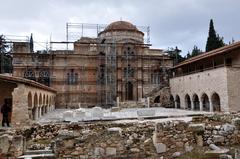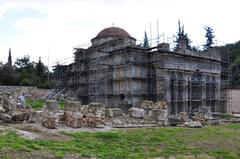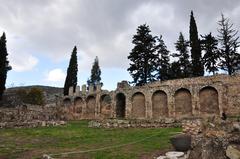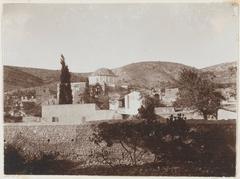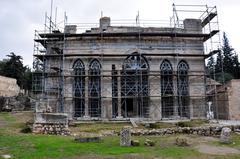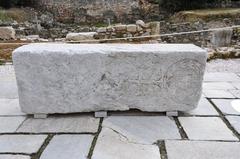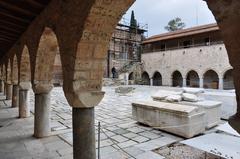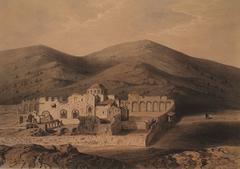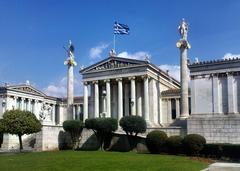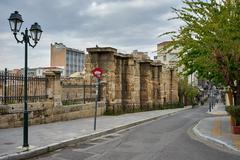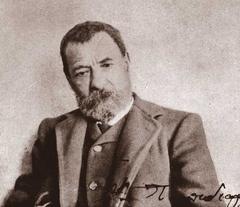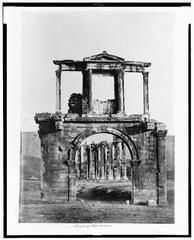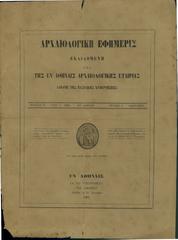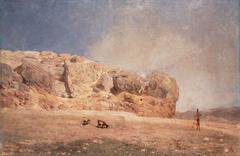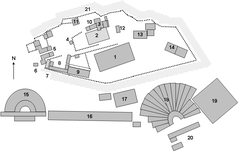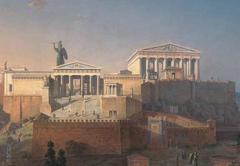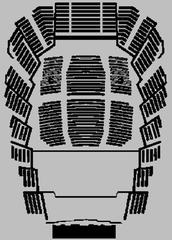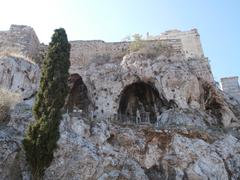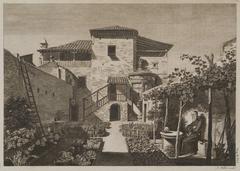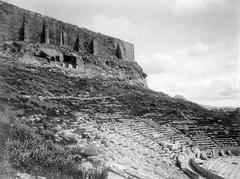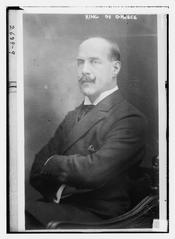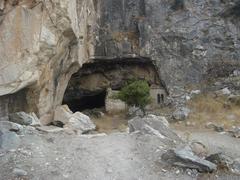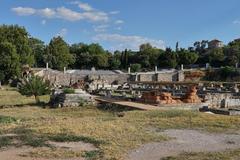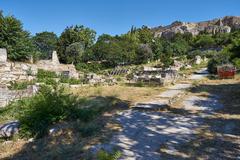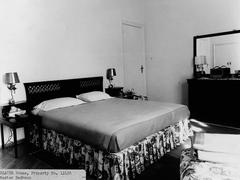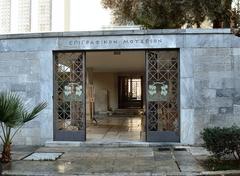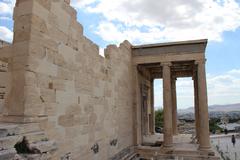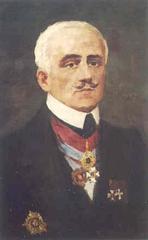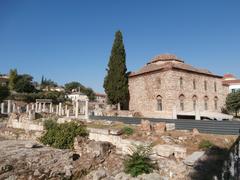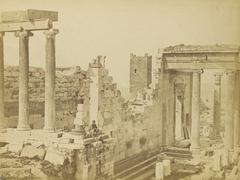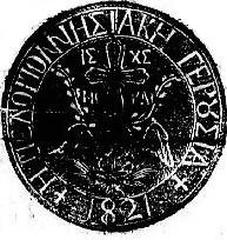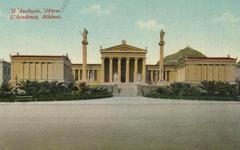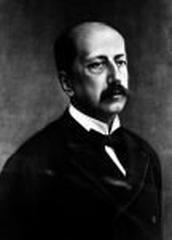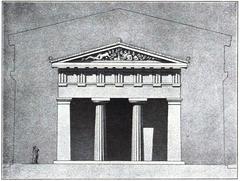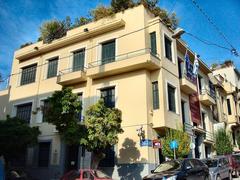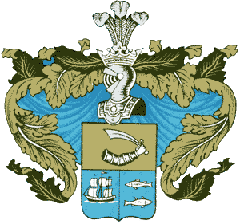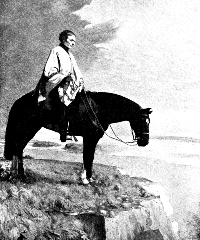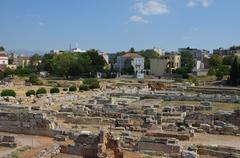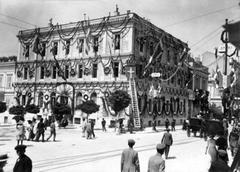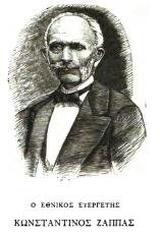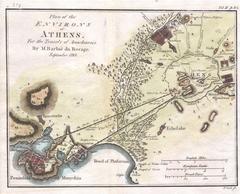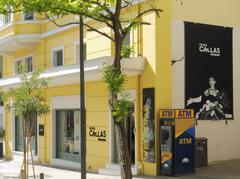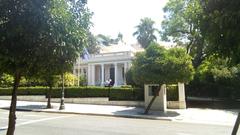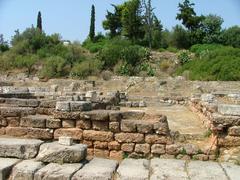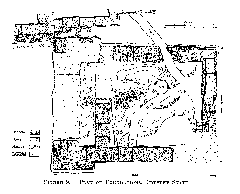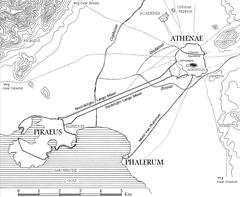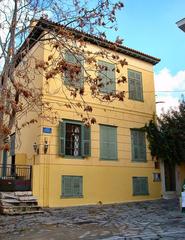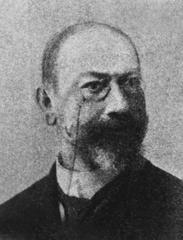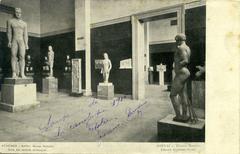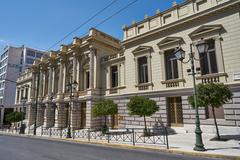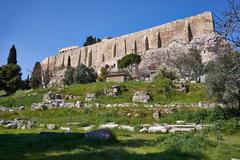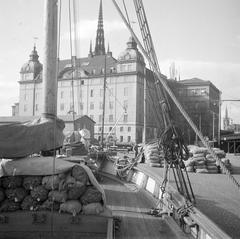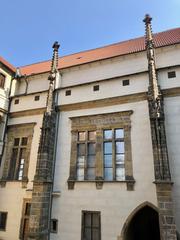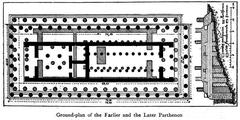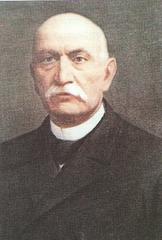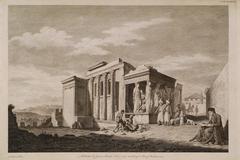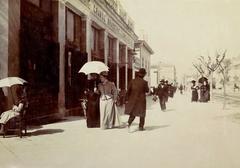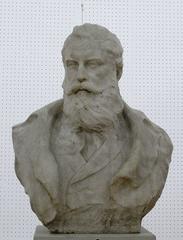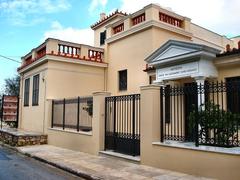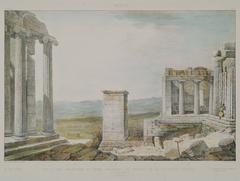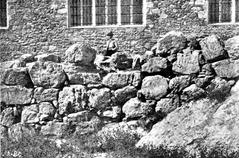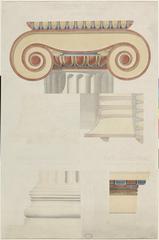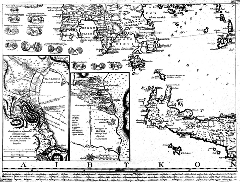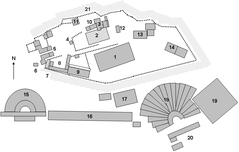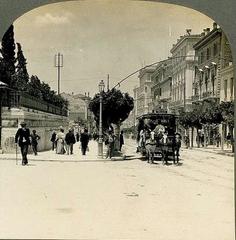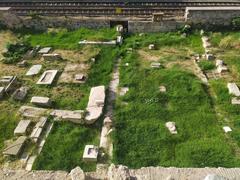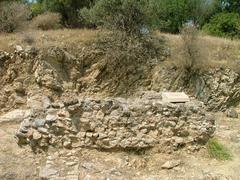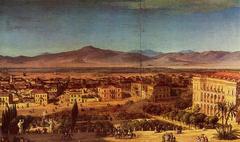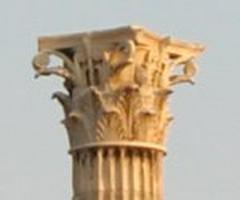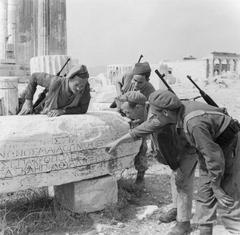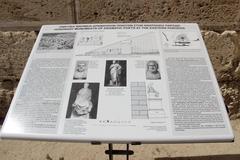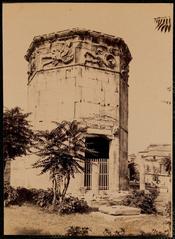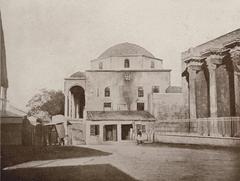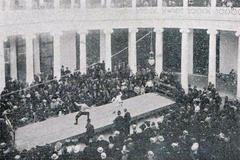
Visiting Hours, Tickets, and Historical Insights of Μονή Δαφνίου, Athens
Date: 24/07/2024
Introduction
The Daphni Monastery, known in Greek as Μονή Δαφνίου, is an awe-inspiring testament to Athens’ rich historical and cultural heritage. Nestled in the serene Haidari suburb, approximately 11 kilometers from the bustling center of Athens, this UNESCO World Heritage Site offers visitors an immersive journey through Byzantine artistry and architecture (Travel the Greek Way). The monastery’s origins date back to the 6th century, constructed on the site of an ancient temple dedicated to Apollo Daphnaios, which was destroyed by the Goths in 398 CE (Wikipedia). Today, it stands as a significant monument, not only for its historical context but also for its exquisite mosaics and architectural marvels. This comprehensive guide aims to provide detailed information on visiting the Daphni Monastery, covering its history, visiting hours, ticket information, and more, ensuring that your visit is both educational and enriching.
Table of Contents
- Introduction
- Historical Background
- Architectural Marvels
- Artistic Highlights
- Visitor Information
- Nearby Attractions
- Special Events and Guided Tours
- Photographic Spots
- FAQ Section
- Conclusion
Historical Background
Early Foundations and Ancient Roots
The site of the Daphni Monastery, built on the ancient sanctuary of Apollo Daphnaios, has a history that stretches back to ancient times. Destroyed during the Gothic invasion in 395 A.D., the sanctuary’s name is perpetuated in the monastery (Wikipedia).
Byzantine Influence
The monastery underwent significant renovations in the 11th and 12th centuries, during which it was adorned with exquisite golden mosaics. These mosaics are considered masterpieces of middle Byzantine art and architecture, showcasing the artistic and religious fervor of the period (Atlas Obscura).
Strategic Location
Situated along the Iera Odos, one of Greece’s oldest and most trafficked routes, the Daphni Monastery served as an intermediary stop for various armies and travelers over the centuries. This strategic location made it a customary stop for philhellenic travelers on their way to the sacred city of Eleusis and the Peloponnese (Travel the Greek Way).
Architectural Marvels
The Catholicon
The main temple, or Catholicon, of the Daphni Monastery is renowned for its architectural excellence. This domed church, dedicated to the Dormition of the Virgin Mary, dates back to the 11th century. The large dome is supported by eight symmetrically arranged pillars, with chapels positioned in the corners of the building. The smooth surfaces of its walls and the ornate brickwork surrounding the windows are testaments to the exceptional craftsmanship of the Greek Byzantine school (Travel the Greek Way).
Fortified Enclosure
One of the unique features of the Daphni Monastery is its imposing fortified enclosure wall, standing nearly 20 feet high. This wall is complete with towers, battlements, and two entry gates, with the smaller gate serving as the main entrance today. This fortified structure adds a layer of historical intrigue and defensive significance to the site (Travel the Greek Way).
Artistic Highlights
Mosaics
The Daphni Monastery is famed for its exceptional mosaics, which are set against a gold background and boast outstanding artistic characteristics. The main mosaic in the center of the dome is Christ Pantokrator (Ruler Over All), flanked by 16 prophets of the Old Testament. These mosaics showcase innovations and new iconographic styles, with a distinct emphasis on the human aspect of depicted saints and scenes from the life of the Virgin Mary (Travel the Greek Way).
Frescoes
The frescoes on the walls of the Catholicon are in full harmony with the Byzantine architecture, adding to the overall aesthetic and spiritual experience of the monastery. The reduction in the depiction of individual saints, compared to other Greek Orthodox monasteries, is a notable feature, emphasizing the human aspect of the saints depicted (Travel the Greek Way).
Visitor Information
Visiting Hours
The monastery is open to the public from 8:00 AM to 3:00 PM, Tuesday to Sunday. It is closed on Mondays and public holidays (Time Travel Turtle).
Tickets
Entrance to the monastery is €6 for adults, with reduced rates for students and senior citizens. Free entry is available for children under 18 and EU students (Time Travel Turtle).
Travel Tips
The monastery is accessible by car or public transport from central Athens. Visitors can take the Metro (M3 line) to Agia Marina Station, then transfer to bus 866, 876, or 811 for an 11-stop trip to Daphni Hospital, located across the road from the monastery. Ample parking is available on-site (Travel the Greek Way).
Accessibility
The site is partially accessible to visitors with mobility issues. Contact the monastery in advance for more information on accessibility.
Duration of Visit
While the Daphni Monastery is relatively small, the detailed mosaics and frescoes can captivate visitors for longer than expected. Most visitors spend around 30 minutes exploring the site, including the church and the small museum. However, those with a keen interest in Byzantine art and architecture may find themselves spending more time appreciating the intricate details (History Fangirl).
Guided Tours
Although there are not many tours specifically focused on the Daphni Monastery, it is often included as part of broader day trips. The site features informative signs, and friendly attendants are usually available to answer questions and provide additional insights (Time Travel Turtle).
Nearby Attractions
Visitors to the Daphni Monastery can also explore nearby attractions such as the Diomedes Botanical Garden and the historic city of Eleusis, known for its ancient ruins and the Eleusinian Mysteries (Travel the Greek Way).
Special Events and Guided Tours
The monastery occasionally hosts special events and guided tours. Check the official website or contact the Archaeological Service for the latest information on upcoming events and tour schedules (Time Travel Turtle).
Photographic Spots
For photography enthusiasts, the best spots include the Katholikon’s interior, the mosaic decorations, and the panoramic views from the monastery grounds.
FAQ Section
What are the visiting hours for Μονή Δαφνίου?
The monastery is open from 8:00 AM to 3:00 PM, Tuesday to Sunday.
How much are the tickets for Μονή Δαφνίου?
Tickets are €6 for adults, with reduced rates for students and seniors, and free entry for children under 18 and EU students.
Is Μονή Δαφνίου accessible by public transport?
Yes, the monastery is accessible by public transport from central Athens.
Are there any guided tours available?
Yes, guided tours are occasionally available. Check the official website for the latest information.
What nearby attractions can I visit along with the Daphni Monastery?
Nearby attractions include the Diomedes Botanical Garden and the archaeological site of Eleusis.
Conclusion
The Daphni Monastery offers visitors a captivating journey through Byzantine art, history, and architecture. With its strategic location, impressive mosaics, and rich cultural significance, it stands as a testament to Greece’s enduring heritage. Whether you’re a history enthusiast, an art lover, or simply looking for a peaceful retreat, the Daphni Monastery promises an enriching experience. Plan your visit today and immerse yourself in this historical gem (Time Travel Turtle).


